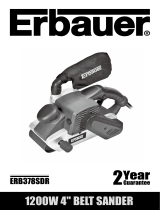
EBS76 09
LUMBERJACK GUARANTEE
1. Guarantee
1.1 Lumberjack guarantees that for a period of
12 months from the date of purchase the
components of qualifying products (see clauses
1.2.1 to 1.2.8) will be free from defects caused
by faulty construction or manufacture.
1.2. During this period Lumberjack, will repair or
replace free of charge any parts which are
proved to be faulty in accordance with
paragraph 1.1 providing that:
1.2.1 You follow the claims procedure set out in
clause 2
1.2.2 Lumberjack and its authorised dealers are
given reasonable opportunity after receiving
notice of the claim to examine the product
1.2.3 If asked to do so by Lumberjack or its
Authorised dealer, you return the product at
your own cost to Lumberjack’s or supplying
Authorised Dealer’s premises, for the
examination to take place clearly stating the
Returns Material Authorisation number given by
Lumberjack or an Authorised Dealer.
1.2.4 The fault in question is not caused by
industrial use, accidental damage, fair wear and
tear, wilful damage, neglect, incorrect electrical
connection, misuse, or alteration or repair of the
product without approval.
1.2.5 The product has been used in a domestic
environment only
1.2.6 The fault does not relate to consumable
items such as blades, bearings, drive belts, or
other wearing parts which can reasonably be
expected to wear at different rates depending
on usage.
1.2.7 The product has not been used for hire
purposes.
1.2.8 The product has been purchased by you as
the guarantee is not transferable from a private
sale.
2. Claims Procedure
2.1 In the first instance please contact the
Authorised Dealer who supplied the product to
you. In our experience many initial problems with
machines that are thought to be faulty due to
faulty parts are actually solved by correct setting
up or adjustment of the machine. A good
Authorised Dealer should be able to resolve the
majority of these issues much more quickly than
processing a claim under the guarantee. If a
return is requested by the Authorised Dealer or
Lumberjack, you will be provided with a Returns
Material Authorisation number which must be
clearly stated on the returned package, and any
accompanying correspondence. Failure to provide
a Returns Material Authorisation number may
result in item being refused delivery at Authorised
Dealer.
2.2 Any issues with the product resulting in a
potential claim under the guarantee must be
reported to the Authorised Dealer from which it
was purchased within 48 hours of Receipt.
2.3 If the Authorised Dealer who supplied the
product to you has been unable to satisfy your
query, any claims made under this Guarantee
should be made directly to Lumberjack. The Claim
itself should be made in a letter setting out the
date and place of purchase, giving a brief
explanation of the problem which has led to the
claim. This letter should be then sent with proof



















